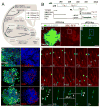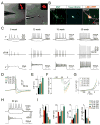Functional maturation of hPSC-derived forebrain interneurons requires an extended timeline and mimics human neural development
- PMID: 23642366
- PMCID: PMC3699205
- DOI: 10.1016/j.stem.2013.04.005
Functional maturation of hPSC-derived forebrain interneurons requires an extended timeline and mimics human neural development
Abstract
Directed differentiation from human pluripotent stem cells (hPSCs) has seen significant progress in recent years. However, most differentiated populations exhibit immature properties of an early embryonic stage, raising concerns about their ability to model and treat disease. Here, we report the directed differentiation of hPSCs into medial ganglionic eminence (MGE)-like progenitors and their maturation into forebrain type interneurons. We find that early-stage progenitors progress via a radial glial-like stem cell enriched in the human fetal brain. Both in vitro and posttransplantation into the rodent cortex, the MGE-like cells develop into GABAergic interneuron subtypes with mature physiological properties along a prolonged intrinsic timeline of up to 7 months, mimicking endogenous human neural development. MGE-derived cortical interneuron deficiencies are implicated in a broad range of neurodevelopmental and degenerative disorders, highlighting the importance of these results for modeling human neural development and disease.
Copyright © 2013 Elsevier Inc. All rights reserved.
Figures







Comment in
-
Human cortical interneurons take their time.Cell Stem Cell. 2013 May 2;12(5):497-9. doi: 10.1016/j.stem.2013.04.017. Cell Stem Cell. 2013. PMID: 23642355
References
-
- Anderson SA, Marin O, Horn C, Jennings K, Rubenstein JL. Distinct cortical migrations from the medial and lateral ganglionic eminences. Development. 2001;128:353–363. - PubMed
-
- Butt SJ, Fuccillo M, Nery S, Noctor S, Kriegstein A, Corbin JG, Fishell G. The temporal and spatial origins of cortical interneurons predict their physiological subtype. Neuron. 2005;48:591–604. - PubMed
Publication types
MeSH terms
Substances
Associated data
- Actions
Grants and funding
LinkOut - more resources
Full Text Sources
Other Literature Sources
Molecular Biology Databases

